Study: The contribution of decentralized electrolyzers to the energy transition

Project description
On behalf of the energy supplyer Green Planet Energy, the RLI is preparing a study that examines the role of electrolyzers for hydrogen production for the energy transition.
Hydrogen can be an important component in the transition to a climate-neutral energy system. When it is produced by electrolyzer from renewable energy electricity, it is called “green” hydrogen. Green hydrogen is climate-friendly, can be stored, and is easy to transport over long distances. It thus contributes to sector coupling – a key concept in the energy transition – and becomes the basis for climate-neutral mobility, industry, and heat supply.
Green hydrogen as an important flexibility option in the energy system
In electrolysis, water is split into hydrogen and oxygen by applying an electrical voltage. At present, however, it is not clear what kind of electrolyzers would be useful for the energy transition in Germany. Should they be small and decentralized, or are high loads at central production sites the best solution? What are the advantages and disadvantages of the different electrolyzers? These and other questions are discussed in this study, with a focus on small electrolyzers.
Which electrolyzer can do what?
The study includes an inventory of existing electrolyzers, as well as a look at their various sizes, performance classes, operating concepts, target groups, and costs. Their respective potential for supporting the energy transition is analyzed depending on the application. Special emphasis is on:Flexibility in the production and offtake of hydrogen.
- Ability to integrate fluctuating renewable energy
- Local value creation and acceptance
- Transportation and storage needs
- Ability to use byproducts, such as heat and oxygen
Three different utilization scenarios are used to examine the advantages and disadvantages of small electrolyzers in each case. The findings from the utilization scenarios are summarized in a SWOT analysis.
Where do electrolyzers fit in?
In the second part of the study, five reference grid areas are used to illustrate the contribution that small electrolyzers can make to meeting hydrogen demand. The reference grid areas correspond to typical grid area classes, which can be roughly categorized as PV-dominated, wind-dominated, and load-dominated. The role that small electrolyzers can play in the implementation of the National Hydrogen Strategy (NWS) is also examined. Finally, a qualitative assessment of the impact on the required power grid infrastructure is made using the results.
Project duration: July – December 2021
Tasks
- Inventory of available electrolyzer modelsDefinition and classification of sizes and performance classes
Analysis of potential for the energy transition - Evaluation of opportunities and risks of small electrolyzers in regional contextsAnalysis of three utilization scenarios
- SWOT analysis
- Analysis of the contribution of small electrolyzers to the hydrogen economyRepresentation based on five reference grid areas
- Examination of the role of small electrolyzers in the implementation of the National Hydrogen Strategy
- (NWS)Assumptions based on the 100% (eGo 100) and 75% (NEP 2035) renewable energy future scenarios from the open_eGo project
- Determination of the electricity price needed for economic operation using the simulation tool SMOOTH per reference grid area
Results
Find the complete study here (in German only):

